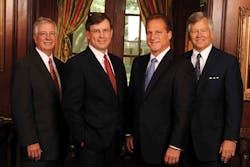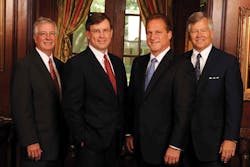Mutual of Omaha Bank forms energy lending group
Mikaila Adams, Senior Associate Editor, OGFJ
As a full-service bank with more than $5 billion in assets, Mutual of Omaha Bank provides financial solutions to individuals and businesses in communities across the US. What started in November of 2007 as a subsidiary of Mutual of Omaha, the well-known insurance and financial services parent company with over 100 years of history, has grown into a network of banks and offices in Arizona, California, Colorado, Florida, Iowa, Missouri, Nebraska, Nevada and Texas. True to its pursuit of growth, the bank has formed an energy lending group to be based in the Houston office it opened in January of 2010.
Not long after the announcement, energy veterans George McKean and Edward Fenk spoke to OGFJ about their move to the bank, the formation of the energy lending group, and the bank's plans in the energy lending space.
McKean was named manager of energy lending at the bank. His 25 years of experience in the industry, including his previous position as managing director at CIT Group in Houston where he established a Houston-based energy lending group for the company, certainly lends itself to his newest role at Mutual of Omaha Bank.
Fenk, also an energy lending veteran, brings 30 years of experience to his new role as senior energy lender at Mutual of Omaha Bank. He most recently served as vice president of the Corporate Banking Energy Industry Team at Allied Irish Bank in Houston.
The strength of the Mutual of Omaha brand and the company's culture are what drew McKean and Fenk to the new group.
"Mutual of Omaha is a well-known name. The knowledge and prior experience of the senior management team was an important plus when we were looking to transition to the bank and start a group," said McKean. "The culture at the bank is something that we viewed as a positive. The desire to grow and the willingness to look at new business lines were important as well," he continued.
The Mutual of Omaha name was a draw for Fenk, as well. "Mutual of Omaha is a name that we've all grown up with…it's one that carries a great deal of trust in the marketplace."
"You often see it when dealing with potential borrowers; they're looking for lenders that are going to be reliable partners," said Fenk, noting that institutions entering the marketplace for the first time often spend long periods establishing themselves and their brand among other lenders and borrowers. "Mutual of Omaha carries with it a whole legacy of trust and reliability. What we've found in going to prospective clients is that they're willing to open up to us and spark a dialogue. It's been an invaluable tool in opening doors and dealing with potential borrowers as well as other banks. There's a large value behind the brand that both George and I were attracted to and wanted to become a part of in joining this team," Fenk continued.
As for the timing of the company's decision to start an energy lending business, McKean said the bank was looking to grow its overall business. Many in senior management had been active in energy lending in former positions, and the bank saw an opportunity to expand its business line.
"It's an area where senior management has lending experience and understands the market," said McKean.
Deal structure
In general, the lending group is looking to fund exploration and production (E&P) and midstream projects from small and midsized producers, both public and private. "Our target deal size is going to be $5 million to $50 million. We can do that as part of a sole lender club deal or participation in a broader syndicated facility," said McKean.
"We're loan product driven and we're yield driven, so it's going to be the smaller companies looking to utilize their borrowing base lines that we're naturally attracted to," added Fenk.
While primarily focused on financing E&P and midstream projects, lending to oilfield services companies will also be a part of the group's business. "One of the things that got me interested in Mutual of Omaha Bank is the fact that they have gotten comfortable with the risks on the oilfield services side of the business and executed several transactions there," noted McKean.
Spearheading the effort is Forrest Taylor whose expanded role within the company saw him join the energy lending group a few short weeks after McKean and Fenk.
Risk
Recognizing the economic turmoil of the past few years, the energy lending group will mitigate risk wherever possible.
A key element is in the partnerships it selects. "We're going to look for experienced management teams," said McKean. "A lot will be driven by the fact that, as part of the senior secured borrowing base and term loans that we're looking at, there will need to be, as with all senior secured first lien lending, a healthy component of producing reserves or PDPs. That, inherently, is going to lead to management teams that have experience, that have been successful, and are either growing organically through developing their own assets or looking to acquisitions to grow assets."
The deal structures play a large role in balancing risk, as well.
As Fenk noted, "Even during those trying times, the preferred reserve base lending asset class performed very well. These are well-structured transactions that protect lenders. There were incidents of default during this last industry turndown, but generally the losses, given default, were very low."
The structures performed the way they were intended and the protections that the lenders rely on — twice yearly redeterminations, the reliance on safe collateral, and the ability of lenders to proactively manage their exposures after closing and throughout the term of the loan — are all taken into consideration, explained Fenk.
"As George said, we will of course focus on the management teams and company strategy, but we'll do that within the conforming structure of the reserve based loan which itself gives borrowers great many protections," he continued.
Wild swings in oil prices are another factor taken into consideration.
Like other first lien lenders, said McKean, the group will employ a relatively conservative price deck. "We'll look at resetting our price deck at least semi-annually and look at it as a discount or percentage to the current market price. We're not going to use the NYMEX strip as a price deck."
And, he continued, the group will stay in contact with other lenders to maintain a feel for transactions in the market. "The intention is that our price deck will be in line with other first lien lenders in the market," he explained.
While staying in contact with other lenders is important, the group hopes its background will help set them apart.
McKean, who has held senior officer positions at multiple financial institutions as well as energy companies, said the group's financial background coupled with its technical background is a major strength.
Fenk, who is a certified petroleum geologist and a licensed attorney, is also a veteran of both financial institutions and oil and gas companies.
"Experience on the technical side is something we view as a real strength. It's a lot of direct work experience at energy companies. The ability to understand where they're coming from and what they're thinking is a critical piece of what we bring to the table," McKean concluded.
More Oil & Gas Financial Journal Current Issue Articles
More Oil & Gas Financial Journal Archives Issue Articles
View Oil and Gas Articles on PennEnergy.com

